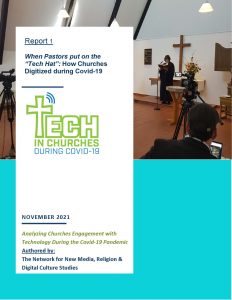When the Church Went Digital – Professor Leads Research on the Rise of Remote Worship
Churches and religious organizations faced struggles moving to virtual formats at the start of the COVID-19 pandemic.
By Ronaldo Mata

Heidi Campbell is a professor in the Communication Department and affiliate faculty in Religious Studies.
When the pews had to empty in 2020 due to the pandemic, faith leaders began to innovate ways to stay connected to their congregations. A recent report by A&M Department of Communication Professor Heidi Campbell analyzes how technology helped houses of worship keep the faith at a time it was most needed and what role tech will play in the future of religious communities.
Data from focus groups with 478 Indiana religious leaders led to the first of Campbell’s three-part research project – “When Pastors Put on the ‘Tech Hat:’ How Churches Digitized during COVID-19.” The goal is to analyze the role technology played to create a supportive atmosphere of care and community against the backdrop of the pandemic. Campbell’s research focuses on “digital religion,” exploring how religion online and offline meets in digital culture. An A&M Presidential Impact Fellow, Campbell is also affiliate faculty in Religious Studies; director of the Network for New Media, Religion and Digital Culture Studies; and one of the founders of Digital Religion studies.
Campbell explained that understanding how church leaders decide what tech to invest in – and the failures and successes that came with it – was the project’s first focus area. Her research team of undergraduate research assistants is also studying how technology impacts worship and religious communities and the long-term effects these changes will have on the social and theological aspects of a congregation. The team is currently analyzing research for their second stage of research.
Making Adjustments

Data from focus groups with 478 Indiana religious leaders led to the first of a three-part research project.
For more than 25 years, Campbell has studied how people, particularly religious groups, use the internet and technology to practice their faith. While technology’s presence in everyday life continues to increase, she explained that some places of worship were still hesitant to change traditional ways. Then the pandemic broke out.
“Overnight,” Campbell said, “churches that were anti-technology, or at least hesitant, had to learn how to use it quickly because it was either that or stop services altogether.”
A grant by the Lilly Endowment, a philanthropic organization dedicated to religious, educational and community outreach, allowed Campbell to collaborate with the Center for Congregations based in Indianapolis. The Center for Congregations supported more than 2,700 congregations in Indiana needing tech equipment to reach their audience at the beginning of the pandemic. Information on what tech church leaders wanted – and used – was provided to Campbell and her team for further research.
Grant receiving churches included many different denominations, and what they had in common was a need for technology solutions for holding worship online. While some churches in their study have large congregations and buildings, Campbell said the average church is a small one found in rural parts of Indiana.
“Oftentimes, when people think of ‘church,’ they think of these really big churches, but the average church in the U.S. is around 63-85 people,” Campbell explained. The conversion to a tech-based service in a smaller setting is more difficult since many lack a large or full-time staff and rely on volunteers for things like Sunday school or essential tech equipment. Campbell noted that the advanced age of the typical church volunteer and people attending or hosting virtual services also added to the steep learning curve of many congregations.
“One [pastor] said they had to borrow a smartphone from one of the elders of their church, and then they taped it to a ladder,” explained Campbell. “They didn’t even have a tripod.”
Virtual ‘Barrier’
For Campbell’s research team members, such as research assistant Madison Hejny, technology and social media are just another part of life. Hejny, a self-described devout Catholic, said the 2020 switch to remote came easily to the Texas A&M Class of ’22 senior. Still, she describes the experience as different.
“For me, it was easy to accept church [via] the internet,” Hejny said. “The problem for me was more like I didn’t really feel a strong connection.”
Online worship can lack the emotional link churchgoers share during in-person services, said Hejny, a “barrier” and why virtual worship services are insufficient to practice faith. Hejny compared it to the transition to remote learning at the height of Covid-19 in 2020.
“In an in-person class, you see other people taking notes, you see other people working, you see other people you know, maybe struggling like you,” Hejny said. “Online, you don’t see that. You feel kind of isolated.”
Hejny and Campbell noticed such themes as they coded the data. Using content analysis methods to study the collected information and observations, they identified several meaningful, cohesive themes related to the impact on churches by their digital transition. Campbell noted that this method is a skill taught in many COMM courses. The trend was clear: church leaders were becoming burnt out.
“According to research, the average pastor in America is 58 years old,” Campbell said. “Even when they made the choice to go online, that meant How do we reach out to people? How are you even going to get access to this if they don’t have wi-fi, or they’re not using smartphones or they’ve never been on Facebook?
“So there were a lot of concerns and challenges,” Campbell noted.
A Changing Environment
Even after getting equipment, Hejny said the responsibilities continued to mount.
“They get this new technology, but then they don’t know how to work it,” explained Hejny. “The pastor feels overworked, and they’re just feeling exhausted at that point.”
The amount of work required by gadgets and Zoom rooms has some congregations rushing to go back to face-to-face. Others, Campbell said, have welcomed new tech as permanent additions to services after going through the trials and tribulations of acquiring and mastering the equipment.
This research, Campbell noted, is marking a pivotal change in how religious groups practice their religion.
“I think in the digital age that people need to have at least basic skills in order to be prepared for ministry,” Campbell said. “This challenges different religious groups about how [they] have and should prepare staff and leaders to be able to adapt to this emerging media culture and technology.”
More information about Campbell’s research, including full findings, can be found at techinchurches.org.
